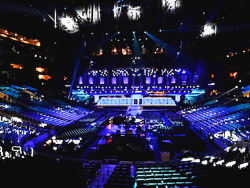
FiberPlex Technologies WDM-16 fiber optic multiplexers and FOI-6010 workboxes were instrumental in getting music from the stage out to the final mobile production truck for broadcast at the recent 57th Annual Grammy Awards show at the Staples Center in downtown Los Angeles.
“When (audio coordinator) Mike Abbott and I first spoke about what methods we were using for MADI to MADI on single-mode fiber is when we decided FiberPlex was an option for the Grammys,” says Joel Singer of Music Mix Mobile (M3), which was responsible for mixing the live music from the stage inside the Staples Center to the broadcast truck outside.
FiberPlex products provided the multiplexing and conversion possible to run multiple MADI streams to and from the stage and music trucks and from the music trucks to the Denali Summit, NEP Broadcasting’s broadcast truck for delivering the live feed to CBS for broadcast.
“FiberPlex had a sizeable presence, and even received screen credit as one of those new technologies that stood out this year,” notes Abbott, who has been the audio director and coordinator for the Grammy Awards for 29 years.
Distribution was done in two steps, the first between the stage microphone preamps and the music trucks and another between the music trucks and the production truck.
M3 used FiberPlex WDM-16 active wavelength division multiplexers to transport and multiplex feeds from its MADI stage racks in the Staples Center onto one single-mode TAC-12 fiber optic strand to its Eclipse and Horizon music trucks. Then, to make the hop from the two music trucks to the Denali Summit truck, M3 used FiberPlex FOI-6010 workboxes to pass MADI channels between the two locations.
In years past, M3 transported mixed music for its trucks to the broadcast truck using an HD-SDI hardware application, which proved to be “mis-spec’d,” according to Singer. “The 3G-SDI products are spec’d for different electrical specifications pertaining to SDI video. MADI has a completely different spec. We needed something that fit that specification, something like the 155 Mbps optical and MADI electrical SFPs we ended up using in the FiberPlex multiplexer and workbox units.”
For the handling the MADI feeds from stage racks, M3 was able to multiplex the signals through the WDM-16 instead of running independent TAC-4 multi-mode fiber to each rack, as had been done in previous years. M3 converged signals from five racks into a WDM-16 at the preamp position, with de-multiplexing of the signals done in the music truck feeding a MADI router. This was done on a duplex pair of single-mode fiber optics provided by M3.
ATK Audiotek (Valencia, CA), the production sound company for the Grammy Awards Show for the past 15 years, handled all live mixing inside the Staples Center. Together, the FOI-6010 and WDM-16 were used to multiplex, transport and convert between media and formats. Both frames support bidirectional ports for interchanging SFP/SFP+ modules capable of converting between analog video, SD/HD & 3G-SDI or HDMI media formats as well as full duplex and BiDi optical, 10/100/1000 Mbps Ethernet and MADI.
The WDM-16 multiplexers in the music trucks used plug-in SFP modules to convert between electrical MADI and high-density BNC connectors for mic preamps – all multiplexed and sent up one strand of fiber. (The multiplexer is a duplex system, so all the signals for monitoring and synchronization were carried as well.)
The WDM-16 multiplexer combines multiple signals on laser beams at various infrared wavelengths for transmission onto fiber optic cable. It multiplexes bi-directionally 16 or more channels of varying types on one fiber cable, each capable of data rates at 3 Gbps per channel for a possible aggregate data rate of 48 Gbps.
The FiberPlex name appeared on the end credits after Sunday’s broadcast by CBS, indicating its technical contribution to the production.
“It was something to see, knowing that our military grade equipment made it to the Grammys and was actually called out during this most important music event,” says Buddy Oliver, president of FiberPlex.
